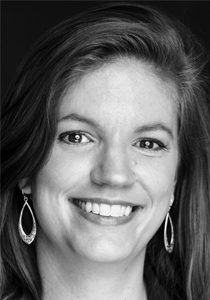Citation

Natalya Gomez’s research is a wonderful example of the power of interdisciplinary thinking in deepening our understanding of the Earth’s climate system. Her earliest work as a graduate student in Toronto and at Harvard focused on sea level change in response to future melting of grounded, marine-based sectors of polar ice sheets. She derived an elegant generalization of ice age sea level theory, and her application to projected melting of the Antarctic Ice Sheet (AIS) yielded predictions of far-field sea level rise significantly higher than standard “fingerprint” calculations, a result with profound implications for the coasts of the United States and Europe.
But Natalya pushed further and was the first to recognize that the combined gravitational and deformational effects that produced a fall in sea level at the grounding line of a retreating, marine-based ice sheet would introduce a self-stabilizing feedback on the ice sheet—a fundamentally new twist on the marine ice sheet instability hypothesis. Working with David Pollard and others, she has coupled ice sheet and sea level models to explore the impact of the feedback on ice age dynamics of the AIS and Northern Hemisphere ice cover and projections of AIS evolution in a warming world. The latter, tour-de-force calculations incorporate the complex variability in Earth structure below the AIS. Most major groups active in this area of cryosphere research have contacted her seeking input or collaboration and have begun incorporating her results into their models. She has, in this regard, given a long list of lectures at conferences, workshops, and universities and is a generous contributor to summer schools, notably, the annual Advanced Climate Dynamics Course in Norway. Natalya and her group are currently exploring a range of problems related to ice sheet stability, sea level, glacial isostatic adjustment, and ocean tides in the ice age Earth and the modern world. In collaboration with David Holland, she has actively moved into field-based research, using GPS measurements in Greenland to monitor sea level changes in Disko Bay and ice loss in the Jakobshavn Glacier. In all this work, she combines the insights of a geophysicist with an interdisciplinary philosophy that is, to quote Walt Whitman, “loos’d of limits and imaginary lines.” She is an impeccable choice for the Early Career Award of the Cryosphere section of AGU.
—Christian Schoof, University of British Columbia, Vancouver, Canada; and Jerry X. Mitrovica, Harvard University, Cambridge, Mass.
Response
I am deeply moved and honored by the generous words from Christian, Jerry, and others who assembled the nomination. Thank you to the nomination committee for honoring my work with this award. I am incredibly thankful to my many supporters and collaborators. Some people have helped in large and very obvious ways, and I am eternally grateful for them. My deeply caring and supportive Ph.D. advisor, Jerry Mitrovica; generous collaborator and mentor David Pollard; my postdoc advisor, David Holland; the faculty and staff in the Department of Earth and Planetary Sciences and beyond at McGill; numerous researchers in the international community who have mentored and made space for me; my peers in graduate school and beyond; and my research group, who continually amaze me with their abilities. Equally important are the people who have silently contributed or offered encouragement and wisdom along the way. I also thank my family and friends, who have been so supportive through it all, keeping me grounded and bringing care, lightness, and perspective when I most needed it.
I am awestruck by the remarkable progress that the cryosphere science community, including the connected areas of sea level, solid Earth, and climate research, has made since I began, and I believe much of this has come through boldly interdisciplinary initiatives. We are constantly open to jumping in temporal and spatial scales, and between data and modeling in different disciplines, to see interconnections and understand things better. I would like to recognize the massive amount of organizational work that has been done to facilitate these advances. We cannot do it alone in cryosphere science, and it has been so exciting to do it together!
Now, more than ever, it is important to cross disciplinary, cultural, and socioeconomic boundaries. We need to fiercely support each other and a diverse, inclusive, next generation of scientists who are taking on some of the most complex and critical problems of our day in the face of ongoing and future climate change. I feel fortunate to have had so many senior scientists, peers, students, and youth set an inspiring example for me on this front, and I am dedicated to continuing to find ways to pay it forward in the next chapters of my career.
—Natalya Gomez, McGill University, Montreal, Que., Canada
Citation:
(2020), Gomez receives 2019 Cryosphere Early Career Award, Eos, 101, https://doi.org/10.1029/2020EO137190. Published on 30 March 2020.
Text © 2020. AGU. CC BY-NC-ND 3.0
Except where otherwise noted, images are subject to copyright. Any reuse without express permission from the copyright owner is prohibited.
